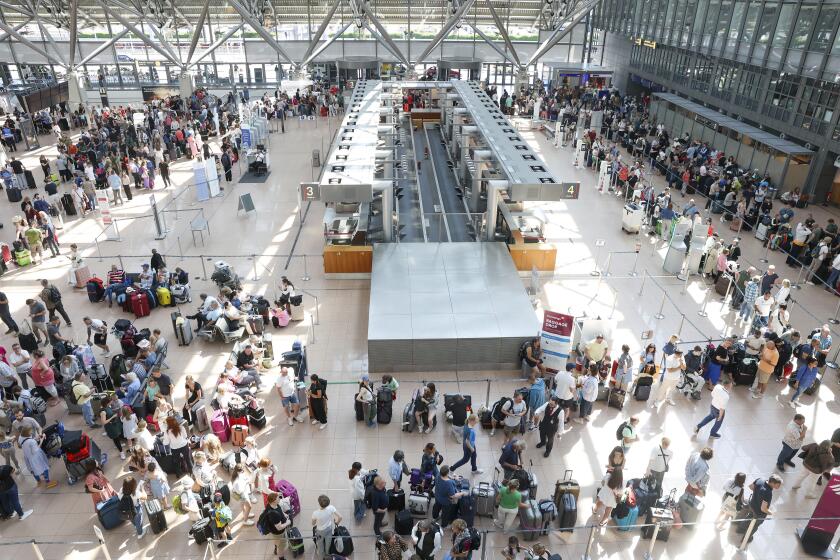Gaudy ‘Jeepneys’ With Their Colorful Drivers Rule the Roads in the Philippines
“Acapulco Gold” comes barreling down the road like a bootlegger with the revenuers on his tail.
Horn blasting, lights flashing, it’s enough to put fear in the heart of any newcomer to the Philippines.
But don’t panic. It’s just a jeepney--a cross between an army truck and a carnival wagon.
The elongated minibuses painted in psychedelic colors--descendants of U.S. Army jeeps left behind after World War II--are the main form of public transport in this southeast Asian nation.
In the countryside, the jeepneys swing down dusty roads with a dozen passengers and parcels crammed inside. Other passengers sit on top with baskets of produce and a few more cling to the sides.
In Manila, 36,000 jeepneys carry passengers from one end of the sprawling capital to the other, charging about five cents a ride and helping give the city its special rhythm.
The jeepneys also can bring the city to a halt--as they did in late August in a strike against a rise in fuel prices.
“Jeepney drivers are a politically potent group. When they stop driving, everything stops,” said Nicolos Acacio, assistant planning secretary for the Department of Transportation.
But the jeepney driver also represents a kind of folkloric figure, tough enough to withstand 13 hours a day of thick diesel fumes and cool enough to roar through red lights without batting an eye.
He’s a master at the wheel, dodging people, pedicabs, horse-drawn carriages and other vehicles on Manila’s crowded and often rough roads.
From time to time, he lurches to the side of the road to let a passenger jump in or out of the back.
Joseph (Jojo) Brown, 25, wouldn’t do anything else. His jeepney--with six-inch red letters proclaiming “Rebelde” (Spanish for rebel)--looks like a Mardi Gras festival inside.
Purple drapes, rosary beads and names of friends adorn the cab up front. In the back, passengers on two long benches sit next to a three-foot-wide sign saying, “Exclusively for Chicks Only.”
From behind the wheel, Jojo peers at the road through a three-inch strip of windscreen, the rest blocked by 143 cassette tapes stacked 11 high on the dashboard. There’s also a red- and blue-tassled sun visor with the words, “Pray for Us.”
“It’s a good job,” he said, swerving to avoid two cows lumbering across the road in the southern outskirts of Manila. “I’m my own boss. I can do what I want. I meet a lot of girls. I’ll do this my whole life.”
Driving up and down Roxas Boulevard alongside Manila Bay, Jojo takes home 300 pesos, or about $15, a day--six times a civil servant’s salary and three times that of a police officer.
Most drivers, though, must rent their jeepneys from an “operator.”
“Buying a jeepney is a Filipino entrepreneur’s dream. It’s the best start-up operation around,” said Romeo Sarao, general manager of jeepney-manufacturer Sarao Motors.
Behind his office two dozen men work in a deafening open-air factory, hammering the galvanized steel bodies of new jeepneys into shape.
The standard model goes for 133,000 pesos, or $6,700. The deluxe, painted in wild colors and adorned outside with metal statuettes of horse and eagles, brightly colored reflectors and metal wings, costs 170,000 pesos, or $8,500.
Signs on the hood give each its special character, screaming out names like “Wild Dogs,” “Heavy Rocker,” “Super Sexy” and “Acapulco Gold.”
“The names give you the impression the person behind the wheel is a character--and he usually is,” said Manuel Domingo, Transportation Department undersecretary.
Sign up for The Wild
We’ll help you find the best places to hike, bike and run, as well as the perfect silent spots for meditation and yoga.
You may occasionally receive promotional content from the Los Angeles Times.



